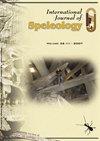Absence of visitors during lockdown reveals natural variation in carbon dioxide level in the Glowworm Cave, Waitomo, New Zealand
IF 1.3
4区 地球科学
Q3 GEOSCIENCES, MULTIDISCIPLINARY
引用次数: 0
Abstract
Waitomo Glowworm Cave is a highly visited cave where the highlight is viewing the bioluminescence display of a large colony of glowworms. Anthropogenic carbon dioxide build-up in the cave is prevented by management of chimney-effect ventilation aided by a network of microclimate sensors. A cave door prevents ventilationunder drying conditions and promotes it when necessary to clear CO2 and when inflowing air has high relative humidity. A COVID-19-related nationwide “lockdown” in New Zealand from March 2020 resulted in neither staff nor visitors being present in the cave for 60 days, and provided an opportunity to assess the natural microclimate of the cave, especially the natural variation in partial pressure of carbon dioxide (pCO2). In addition, comparison to the previous year showed that the presence of people in the cave increased the cave temperatures but the effect was short-lived due to cave ventilation. During the period of lockdown, the daily increase of carbon dioxide partial pressure (pCO2) due to visitors was absent. When the cave door remained sealed, pCO2 varied and tended to lie at levels above that of the external atmosphere (410 ppm). Notably, rain events raised pCO2 by up to 200 ppm (v/v), which appeared to be sourced from both stream water and drip water. These natural CO2 sources rarely reached the levels associated with cave visitation. The results support current management practices that use door control to enhance cave ventilation when people are in the cave or when natural conditions (high stream levels and high drip-water levels) promote CO2 outgassing into the cave. Suppressing ventilation outside of those times reduces the risk of introducing dry air that could desiccate the glowworms.封锁期间游客的缺席揭示了新西兰怀托摩萤火虫洞二氧化碳水平的自然变化
怀托摩萤火虫洞是一个参观人数众多的洞穴,其中最引人注目的是观看一大群萤火虫的生物发光展示。在微气候传感器网络的辅助下,通过管理烟囱效应通风来防止洞穴中人为的二氧化碳积聚。洞穴门在干燥条件下防止通风,在需要清除二氧化碳和流入空气相对湿度较高时促进通风。从2020年3月起,新西兰在全国范围内实施了与covid -19相关的“封锁”,导致工作人员和游客在60天内都没有出现在洞穴中,这为评估洞穴的自然小气候,特别是二氧化碳分压(pCO2)的自然变化提供了机会。此外,与前一年的比较表明,洞穴中有人的存在增加了洞穴温度,但由于洞穴通风,这种影响是短暂的。在封锁期间,由于访客导致的二氧化碳分压(pCO2)每日增加并未出现。当洞穴门保持密封时,二氧化碳分压变化,并倾向于高于外部大气的水平(410 ppm)。值得注意的是,降雨事件使二氧化碳分压升高了200ppm (v/v),这似乎来自溪流和滴水。这些天然的二氧化碳源很少达到与洞穴游客相关的水平。研究结果支持当前的管理实践,即当有人在洞穴中时,或者当自然条件(高流量和高滴水)促进二氧化碳排放到洞穴中时,使用门控制来增强洞穴通风。在这些时间之外,抑制通风可以降低引入可能使萤火虫干燥的干燥空气的风险。
本文章由计算机程序翻译,如有差异,请以英文原文为准。
求助全文
约1分钟内获得全文
求助全文
来源期刊

International Journal of Speleology
地学-地球科学综合
CiteScore
3.10
自引率
23.10%
发文量
12
审稿时长
>12 weeks
期刊介绍:
The International Journal of Speleology has the aim to get cave and karst science known to an increasing number of scientists and scholars. The journal therefore offers the opportunity to all scientists working in and on karst to publish their original research articles or their review papers in an open access, high quality peer reviewed scientific journal at no cost. The journal offers the authors online first, open access, a free PDF of their article, and a wide range of abstracting and indexing services.
 求助内容:
求助内容: 应助结果提醒方式:
应助结果提醒方式:


